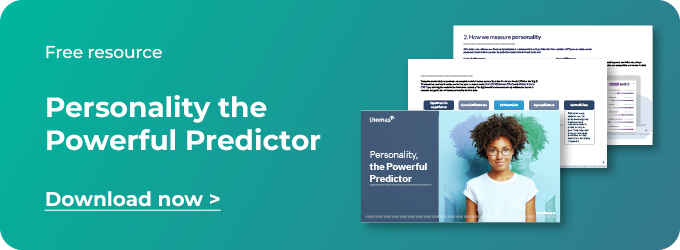Personality theory is important for both businesses and individuals today because identifying one’s own dominant traits and those of others can improve communication and collaboration, leading to more effective relationships and ultimately better results. Personality theory can be used in a variety of contexts, from hiring and team building to leadership development and conflict resolution.
Over the past hundred years, continued research, critical analysis and technological development have contributed to the evolution of theories of behavior and personality. Although other measures of personality, such as the ‘High Potential Trait Indicator’ or (HPTI) personality assessment have since been developed, the original and most widely accepted theory of personality and behavior is ‘DISC’ theory, which designates four different behavioral preferences.
In this guide, we are going to take a look at each of the four personality types and the theories behind them, to gain a better understanding of how using scientifically validated assessment tools to measure personality types can help individuals to excel, and organizations to hire the right candidates and enhance workforce performance.
The history of the four personality types
The DISC model is an easy-to-use but very accurate theory to understand human behaviors. It provides an increased level of self-awareness and awareness of others through a common language and framework of understanding.
In 1928, William Moulton Marston published “Emotions of Normal People”, a book outlining his research into human behavior, in which he asserts that people’s behavior is based on an individual’s perception of and reaction to a situation. Marston grouped these reactions into four major behavioral types or styles, which are sometimes referred to as ‘DISC behavioral types’. The four types are:
D - Dominance
I - Influence
S - Steadiness
C - Compliance
In 1958, Dr Thomas Hendrickson developed the Thomas Behavior assessment, based on Marston’s theory. The DISC profile assessment takes just 8 minutes but remains a highly effective way to understand an individual’s workplace behaviors. This insight empowers individuals and organizations with a greater level of understanding of their capabilities, behavioral alignment with a task or role, likely contribution to a teams and response to pressure. This information can be used to enhance personal and organizational performance in a number of areas, including:
- Tapping into employees’ inherent motivation
- Identifying team and individual strengths and limitations
- Identifying individuals’ preferred communication style
- Enhancing peer and team interactions and de-escalating conflict
- Predicting what will cause stress for an individual and how it will affect them
- Informing highly effective line management and coaching
- Informing HR decision-making with validated, objective data
The DISC behavioral assessment is one of the most valid psychometric assessments, consistently providing an accurate reflection of an individual’s behavioral type. Consequently, it has become one of the most widely used personality assessments worldwide. The Thomas Behavior assessment has been extensively validated by independent regulators, including the Psychometric Testing Centre (PTC) of the British Psychological Society (which itself is based on the criteria of the European Federation of Psychologists’ Associations, EFPA) and the HPCSA (Health Professions Council, South Africa). Thomas continues to carry out research and validation with partners such as Cambridge University’s Judge Business School, to further increase the assessment’s accuracy.

Understanding the four different personality types at work
Marston’s theory plots human behavior along just two dimensions: ‘internal’ and ‘external’, which interact to produce the four different behavioral types, or modes of expression: Dominance, Influence, Steadiness and Compliance. His theory stated that our behavior is determined by whether we perceive our environment to be essentially antagonistic or favorable, and whether we choose to adopt an active or passive response to it.
It is important to understand that whilst some behaviors are more typical of us than others, we are still able to express any of these modes from time to time. Individuals are not exclusively grouped into one category, but they will exhibit more of the behavioral patterns from their dominant behavioral type, whilst still retaining some elements of others. This is what the Behavior assessment measures. The DISC Behavior assessment is an ipsative, or ‘forced choice’ assessment, requiring individuals to select from a set of similar options to quickly determine this preferred behavioral style.
We will now take a closer look at the four behavioral types and highlight some of the key attributes of each.
Dominant personality style
People who have high ‘Dominance’ in their behavioral profiles are driven to accomplish results. They are focused on expediting action, comfortable with challenge, and decisive. Dominance profiles typically prefer brief, direct communication and are likely to be assertive. More comfortable with conflict than other profiles, dominant individuals can come across as curt or even rude without the context that the office provides, especially by team members with opposing communication preferences (those with Steadiness profiles, discussed below).
As self-starters, remote work is unlikely to demotivate dominant types. Due to their drive to succeed, dominant profiles may also be highly conscientious, the trait that most strongly predisposes an individual to succeed at work (MacRae). Strong goal orientation and high standards often correlate with professional success but can also lead to burnout which may be less visible when working in a hybrid setting. Dominance profiles are motivated by autonomy and challenge but are likely to become frustrated when excessive challenges impede the delivery of results.
Managing dominant behavioral types
To empower dominant profiles, managers must be direct and results-oriented, and communicate the big picture. Dominant individuals want to get to the point, achieve results, and attain rewards. Rather than issuing commands, managers can motivate ‘high D’ individuals by asking them how they are going to achieve their goals. Providing the right level of challenge, whilst being alert to signs of stress and burnout is a crucial consideration for managers. Giving more dominant individuals clarity on goals and objectives will help them to deliver and thrive.
Influential behavioral style
People with a predominantly ‘influential’ behavioral style are motivated by their effect on others. They are skilled at forming and cultivating relationships, generating enthusiasm in co-workers, and often radiate optimism themselves. Animated and enthusiastic, influencers are motivated by building relationships and communicating ideas. Often highly verbal, they are natural networkers and shine in discussions, gaining commitment from others, boosting morale and cultivating relationships.
Influential team members may struggle to maintain motivation should they lose access to the social connection and approbation that motivates them. They may also struggle to maintain concentration if working in isolation for long periods of time without the opportunity to collaborate with others. Whilst Influencers’ need for novelty and creativity can work well in hybrid work settings, they will need in-person interaction to maintain high engagement and motivation in the longer term.
Managing influential behavioral types
Individuals with influence as a working strength combined with high levels of curiosity in their personality profile are likely to be some of the quickest to adapt to new ways of working. Influencers thrive through daily interactions, impromptu conversations and the wellbeing boost of socializing with colleagues, clients and customers. Buddy systems, mentoring and coaching, celebrating team accomplishments and creating space for informal discussion during conference calls will help influence profiles maximize productivity.
Influence profiles will succeed if given plenty of opportunity to build relationships. They are the energizers in your team, so creating outlets for social connection will allow them to shine while raising morale team-wide. To reduce isolation, prevent new hires from feeling lost, and help employees feel part of hybrid teams, it’s important not to leave engagement to chance when it comes to managing influencers. To engage influencers, managers should check in regularly via video call, and proactively take an interest in them and their feelings.

Steadiness behavioral style
People with ‘Steadiness’ as a working strength deliver consistently through processes and teamwork. They tend to focus on the job at hand and diligently see work projects through to completion. Taking a methodical approach to managing their workload, steadier individuals can persist where other personality styles might more quickly become distracted or lose interest.
Team members who are high in steadiness can help to stabilize teams that are undergoing change. However, people with this personality trait can also be disrupted and demotivated by rapid changes in their working environment. Their levels of emotional resilience and conscientiousness are often deciding factors in their ability to manage disruption.
Individuals with a preference for steady behaviors and low tolerance for stress (adjustment) are likely to find new work environments challenging. They may find that remote work relieves some of the stressors present in traditional working environments, such as workplace conflict, interruptions from colleagues and commuting.
Managing high steadiness behavioral types
Steadier individuals thrive in a secure environment that affords them the psychological safety to raise their concerns. For more steady and compliant behavioral profiles, maintaining engagement and wellbeing in the workplace means complementing listening mechanisms with forums for sharing. Leaders who model emotional intelligence, fireside chats and reverse town halls can all be beneficial for maximising engagement among steadiness-centered staff. Steadier types may prefer to listen than speak, and managers can support their characteristic thoroughness by increasing their ability to concentrate, whether that means muting Slack or helping them structure their work.
Compliance behavioral style
People with ‘Compliance’ as a working strength are excellent fact-checkers and risk assessors. Detail oriented, these individuals are typically focused on maintaining and improving standards, analyzing information and monitoring and controlling quality.
Compliant individuals may be more easily derailed by disruption to existing systems than other types. High change work settings may be stressful and ultimately demotivating for people with this behavioral preference. However, compliance is also critical to successfully managing change, contributing in-depth analyses, enforcing quality standards, assessing risk and exercising diplomacy.
Managing compliant behavioral types
To set compliant individuals up for success, managers must provide detailed updates, reassurance and clearly defined objectives. Assigning logical, analytical tasks and forwarding materials in advance of face-to-face meetings will help to get the most out of compliant types. High change work environments can feel chaotic to highly compliant individuals, so it is important that firms take a scientific approach to experimentation, communicating results sincerely, continuously and logically to their more compliant team members.
How to test for the 4 personality types
A behavioral assessment is a simple questionnaire that uses widely accepted psychological theories to help gain a comprehensive insight into a person's suitability to a role. It looks at areas such as an individual’s communication style, self-direction and approach to change to determine their preferred behavioral style.
Objective insights from a behavioral assessment offer instant self-awareness that is valuable for improving the professional performance of individuals, teams and organizations. Thomas’ behavioral assessment provides a comprehensive analysis of an individual’s primary behavioral type and its impacts in the workplace. This can provide employers with vital insights that enhance recruitment and development decision-making.
Whatever your preferred behavioral style, assessments improve our understanding of the different ways individuals interact with our environment and our colleagues. We all exhibit a variety of different behavioral styles, but an awareness of our behavioral preferences can accelerate career progression and organizational productivity.
If you would like to learn more about our assessments, please speak to one of our team.





